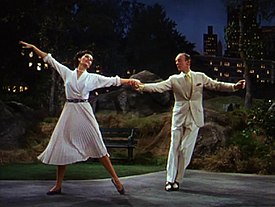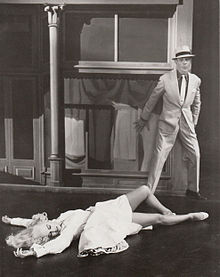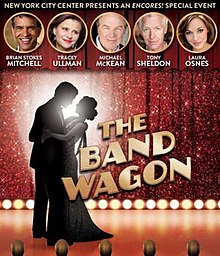| The Band Wagon | |
|---|---|
 Theatrical release poster Theatrical release poster | |
| Directed by | Vincente Minnelli |
| Written by | |
| Produced by | Arthur Freed |
| Starring | |
| Cinematography | Harry Jackson |
| Edited by | Albert Akst |
| Music by | |
| Color process | Technicolor |
| Production company | Metro-Goldwyn-Mayer |
| Distributed by | Loew's, Inc |
| Release date |
|
| Running time | 111 minutes |
| Country | United States |
| Language | English |
| Budget | $2.9 million |
| Box office | $3.5 million |

The Band Wagon is a 1953 American musical romantic comedy film directed by Vincente Minnelli, starring Fred Astaire and Cyd Charisse. It tells the story of an aging musical star who hopes a Broadway show will revive his career. However, the play's director wants to make it a pretentious retelling of the Faust legend and brings in a prima ballerina who clashes with the star. Along with An American in Paris (1951) and Singin' in the Rain (1952), it is regarded as one of the finest Metro-Goldwyn-Mayer musicals, although it was a box-office disappointment on first release.
The songs were written by the team of composer Arthur Schwartz and lyricist Howard Dietz. Schwartz was a prolific Hollywood composer who teamed with numerous lyricists over the years, while Dietz, a studio publicist, generally collaborated with Schwartz. Some of the songs in the film had been created for the original 1931 Broadway musical by Schwartz and Dietz, also titled The Band Wagon, with a book by George S. Kaufman and starring Fred Astaire and his sister Adele. The movie's dances and musical numbers were staged by Michael Kidd.
The song "That's Entertainment!", which Schwartz and Dietz wrote specifically for the film, was a hit and has become a standard in popular music. Another song orchestrated by Conrad Salinger, "Dancing in the Dark", is considered part of the Great American Songbook and was from the original Broadway production. Astaire's early number in the film, "A Shine on Your Shoes", was written for a 1932 Broadway revue with music and lyrics by Dietz and Schwartz titled Flying Colors. (It was originally performed by the dancing team of Buddy and Vilma Ebsen). In the film version of The Band Wagon, the song was reworked as a specialty number by jazz arranger Skip Martin to showcase all of Astaire's musical talents.
The musical director was Adolph Deutsch and the production was designed by Oliver Smith working for the first time in motion pictures. The film was nominated for Academy Awards for Best Costume Design, Color, Best Music, Scoring of a Musical Picture and Best Writing, Story and Screenplay.
Screenwriters Betty Comden and Adolph Green, who received the nomination for the screenplay, patterned the film's characters Lester and Lily Marton after themselves; however, the fictional characters were a married couple, and Comden and Green were not romantically involved. The character of an overachieving impresario was developed with the successful producer-director-actor José Ferrer in mind.
In 1995, The Band Wagon was selected for preservation in the United States National Film Registry by the Library of Congress as being "culturally, historically, or aesthetically significant". In 2006, this film ranked number 17 on the American Film Institute's list of best musicals.
Plot
Tony Hunter, once a famous star of musical comedies on stage and later on screen, is largely forgotten after three years without appearing in a film. He returns from Hollywood to New York. At Grand Central Terminal, he is recognized but almost ignored by reporters who are there by chance as Ava Gardner is on the same train. However, he is greeted enthusiastically by his good friends Lester and Lily Marton, and they tell him they have written a stage show, a light musical comedy, that will be a perfect comeback for Tony. They will also act in it, and they already have caught the interest of Jeffrey Cordova, who they say can do anything: Currently he is starring in, as well as directing, a new adaptation of Oedipus Rex that he wrote based on the original Greek story.
As soon as Jeffrey hears Lily outline the play, he declares it to be a brilliant reinterpretation of the Faust legend, which should star Tony and himself as the characters corresponding to Faust and the Devil. The Martons are delighted that he will be acting as well as directing, but Tony is dubious about the Faust idea. Jeffrey declares that the boundaries between genres in the theater are artificial, and "Bill Shakespeare" and Bill Robinson are all parts of the same whole. Tony agrees, and Jeffrey has the Martons rewrite the play as a dark, pretentious musical drama (when Lester also becomes dubious, Lily insists that one person must be in charge and Jeffrey can succeed at anything).
Jeffrey does succeed in arranging for the beautiful and talented ballerina Gabrielle "Gaby" Gerard to join the production, along with Paul Byrd, who is her boyfriend, choreographer, and manager—even though he always insisted that a musical play would be beneath her. When Tony and Gaby meet, they become sarcastic and hostile to each other, but this is actually because they are insecure: Each of them feels much less talented than the other.
Eventually, it all proves too much for Tony, and he walks out. Gaby follows to meet him privately. In his hotel room, she comments that the paintings by famous artists on the wall are better reproductions than usual in a hotel; he says they are his own property, and are originals. She recognizes a painting of ballerinas as an early Degas. Tony and Gaby put their troubles aside, go for a horse-drawn carriage ride, dance together, and realize they can work together after all. They also begin to fall in love.
When the first out-of-town tryout in New Haven proves disastrous, Tony demands that Jeffrey convert the production back into the light comedy that the Martons had envisioned. Jeffrey says that while they will have to find new backers because the original ones have walked out, he will be happy to appear in that show—if Tony is in charge of it. Tony accepts, using his art collection to finance the production. Paul says the show is no longer suitable for Gaby and walks out, expecting her to follow, but she is pleased to stay and work with Tony.
After some weeks on tour to perfect the new lighthearted musical numbers, the revised show proves to be a hit on its Broadway opening. Gaby professes her love to Tony.
Cast


- Fred Astaire as Tony Hunter
- Cyd Charisse as Gabrielle Gerard
- Oscar Levant as Lester Marton
- Nanette Fabray as Lily Marton
- Jack Buchanan as Jeffrey Cordova
- James Mitchell as Paul Byrd
- Robert Gist as Hal Benton
Uncredited
- India Adams as the singing voice of Cyd Charisse
- Ava Gardner as herself (cameo)
- Thurston Hall as Colonel Tripp
- Douglas Fowley as auctioneer
- Madge Blake as investor
- Judy Landon as dancer in troupe
- Bobby Watson as Bobby
- Sue Casey as tall girl in arcade
- Leroy Daniels as shoeshine man in arcade in "Shine on Your Shoes"
- Henry Corden as orchestra leader
- Julie Newmar as model / chorine in "Girl Hunt Ballet"
- Fred Aldrich as hot dog vendor
- Richard Alexander as stagehand
- Jimmy Thompson as Jimmy
- Roy Engel as reporter
- Emory Parnell as man on train
- Herb Vigran as man on train
- Dee Turnell as Barbara
- Dee Hartford as model in "Girl Hunt Ballet"
Musical numbers
See also: The Band Wagon (soundtrack)| This list is incomplete; you can help by adding missing items. (August 2021) |
Source:
- "By Myself" – Tony (introduced in the stage musical Between the Devil)
- "Shine on Your Shoes" – Tony and a shoeshine man (Leroy Daniels; the song was first introduced in the stage musical Flying Colors)
- "That's Entertainment!" – Jeffrey, with Tony, Lester and Lily. This sequence was used in the film Joker: Folie à Deux from 2024.
- "The Beggars Waltz" – danced by Gabrielle, James Mitchell, and corps de ballet
- "High and Low" – Chorus
- "Dancing in the Dark" – danced by Tony and Gabrielle
- "You and the Night and the Music" – Chorus, danced by Tony and Gabrielle
- "Something to Remember You By" – Chorus
- "I Love Louisa" – Tony, Lester, and Lily
- "New Sun in the Sky" – Gabrielle
- "I Guess I'll Have to Change My Plan" – Tony and Jeffrey
- "Louisiana Hayride" – Lily and Chorus (the song was first introduced in the stage musical Flying Colors)
- "Triplets" – Tony, Jeffrey, and Lily (the performers dance on their knees, costumed in baby attire; the song was first introduced in the stage musical Between the Devil)
- "The Girl Hunt Ballet" (inspired by the novels of Mickey Spillane) – danced by Tony and Gabrielle. The music video of Smooth Criminal by Michael Jackson was heavily inspired by this sequence.
- "That's Entertainment!" (reprise/finale) – Lester, Gabrielle, Jeffrey, Tony and Lily
One musical number shot for the film, but dropped from the final release, was a seductive dance routine featuring Charisse performing "Two-Faced Woman". As with the other Charisse songs, her singing was dubbed by India Adams. Adams' recording of the song was reused for Torch Song (1953) for a musical number featuring Joan Crawford. The MGM retrospective That's Entertainment! III (1994) released the Charisse version to the public for the first time. This footage was included with the 2005 DVD release of The Band Wagon.
Release
In seven weeks at Radio City Music Hall in New York City, the film grossed $1,044,000, one of the higher grossing films at the theater. According to MGM records, the film earned distributor rentals of $2.3 million in the U.S. and Canada and $1,202,000 in other countries, resulting in a loss of $1,185,000.
Reception
In a 1999 Guardian article about the importance of the film, Derek Desmond wrote: "But the whole point about The Band Wagon, and one which sometimes makes people underrate it, was the way everything seems to mesh so seamlessly—almost effortlessly, in fact. That was due to Minnelli, whose flair and imagination, admittedly aided by the huge array of MGM talent both behind and in front of the cameras, was matched by his almost perfect control."
Martin Scorsese listed The Band Wagon as his favorite musical.
Stage adaptation

A musical stage adaptation, titled Dancing in the Dark, ran at the Old Globe Theatre in San Diego from March 4 to April 20, 2008, with plans to bring the show to Broadway. Gary Griffin directed, with a book by Douglas Carter Beane and choreography by Warren Carlyle. The cast included Patrick Page as the "deliciously pretentious" director-actor-producer Jeffrey Cordova, Mara Davi playing Gabrielle Gerard, and Scott Bakula as "song-and-dance man" Tony Hunter.
In the Variety review of the musical, Bob Verini wrote: "There's no reason this reconstituted Band Wagon can't soar once it jettisons its extraneous and self-contradictory elements."
A revised version of the stage adaptation under the name The Band Wagon was presented in a staged concert in November 2014 as part of a New York City Center Encores! special event. The cast starred Brian Stokes Mitchell, Tracey Ullman, Michael McKean, Tony Sheldon, and Laura Osnes, with direction and choreography by Kathleen Marshall.
References
- ^ The Eddie Mannix Ledger, Los Angeles: Margaret Herrick Library, Center for Motion Picture Study
- Fordin 1996, p. 409.
- Fordin 1996, p. 401.
- "Complete National Film Registry Listing". Library of Congress. Retrieved September 16, 2020.
- "The Band Wagon (1953) – Soundtracks". IMDb.
- Knowles, Mark (2013). The Man Who Made the Jailhouse Rock: Alex Romero, Hollywood Choreographer. Jefferson, North Carolina: McFarland & Company. ISBN 978-1-4766-0368-1.
Leroy Daniels, who has been mixing shoeshining and bebop at Sixth and Main for 10 years, got his movie break after dancing star Fred Astaire decided he wanted another dancer to do a specialty number called 'Shine Your Shoes'
- Manning, Harriet J. (2016). Michael Jackson and the Blackface Mask. London: Routledge. p. 56. ISBN 978-1-3170-9688-7.
The supportive and uncredited appearance of LeRoy Daniels in his dance with Fred Astaire in The Band Wagon (1953) provides the perfect example of the black sidelining that was standard practice. Of note, this was the only scene in Astaire's filmic career ...
- "Joker: Folie a Deux – 23 DC Easter Eggs & References Explained". Screen Rant. October 4, 2024.
- "TCM (@TCM) on X". X (formerly Twitter).
- Erickson, Glenn (March 11, 2005). "DVD Savant Review: The Band Wagon". DVD Talk.
- "Heat Fails to Wilt B'way Grosses; Martin & Lewis-'Plunder' Wow 140G, 'Roman' Noble 165G, 'Squad' Right 24G". Variety. September 2, 1953. p. 9 – via Internet Archive.
- Malcolm, Derek; Malcolm, By Derek (February 11, 1999). "Vincente Minnelli: The Band Wagon". The Guardian. ISSN 0261-3077. Retrieved October 10, 2024.
- Wilson 2011, p. 72.
- Jones, Kenneth (December 23, 2007). "Douglas Carter Beane Lovingly Steers 'Band Wagon' to Create Dancing in the Dark". Playbill. Archived from the original on December 25, 2007.
- "Dancing in the Dark". Old Globe Theatre. Archived from the original on September 6, 2012. Retrieved October 4, 2015.
- Jones, Kenneth (March 4, 2008). "'The Band Wagon' Has a New Shine on Its Shoes in Dancing in the Dark March 4 – April 13". Playbill. Archived from the original on March 30, 2008.
- Jones, Kenneth (March 19, 2008). "That's More Entertainment: Old Globe Gives Dancing in the Dark an Extra Week". Playbill. Archived from the original on May 12, 2008.
- Verini, Bob (March 16, 2008). "Review: 'Dancing in the Dark'". Variety. Retrieved November 27, 2022.
- Suskin, Steven (November 11, 2014). ""That's Entertainment!" Star-Studded The Band Wagon Brings "Sweet Music" to City Center". Playbill. Archived from the original on December 14, 2014.
Works cited
- Wilson, Michael (2011). Scorsese On Scorsese. Cahiers du Cinéma. ISBN 9782866427023.
Further reading
- Eagan, Daniel (2010). "The Band Wagon". America's Film Legacy: The Authoritative Guide to the Landmark Movies in the National Film Registry. A & C Black. pp. 473–475. ISBN 978-0826-42977-3.
- Fordin, Hugh (1996). M-G-M's Greatest Musicals: The Arthur Freed Unit. New York: Da Capo Press. ISBN 978-0-3068-0730-5.
- Stevenson, Diane (September 2006). "In Praise of Praise: An essay on Stanley Cavell's Philosophy The Day After Tomorrow". Film International. 4 (4): 6–13. doi:10.1386/fiin.4.4.6. ISSN 1651-6826. OCLC 803316091.
External links
- The Band Wagon at IMDb

- The Band Wagon at Rotten Tomatoes

- The Band Wagon at the AFI Catalog of Feature Films

- The Band Wagon at the TCM Movie Database

- Howard Dietz and Arthur Schwartz at Masterworks Broadway
- Newsweek discussion transcript about The Band Wagon
- The Band Wagon at the Internet Broadway Database (1931 stage musical)
- 1953 films
- 1953 musical comedy films
- 1953 romantic comedy films
- 1950s American films
- 1950s English-language films
- 1950s romantic musical films
- American musical comedy films
- American romantic comedy films
- American romantic musical films
- Films about musical theatre
- Films directed by Vincente Minnelli
- Films produced by Arthur Freed
- Films scored by Adolph Deutsch
- Films set in New York City
- Films with screenplays by Betty Comden and Adolph Green
- Metro-Goldwyn-Mayer films
- Musicals by Arthur Schwartz
- United States National Film Registry films
- English-language romantic comedy films
- English-language romantic musical films
- English-language musical comedy films